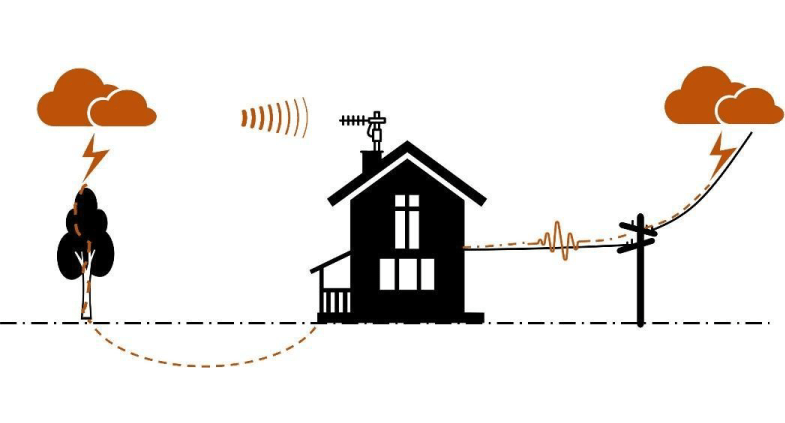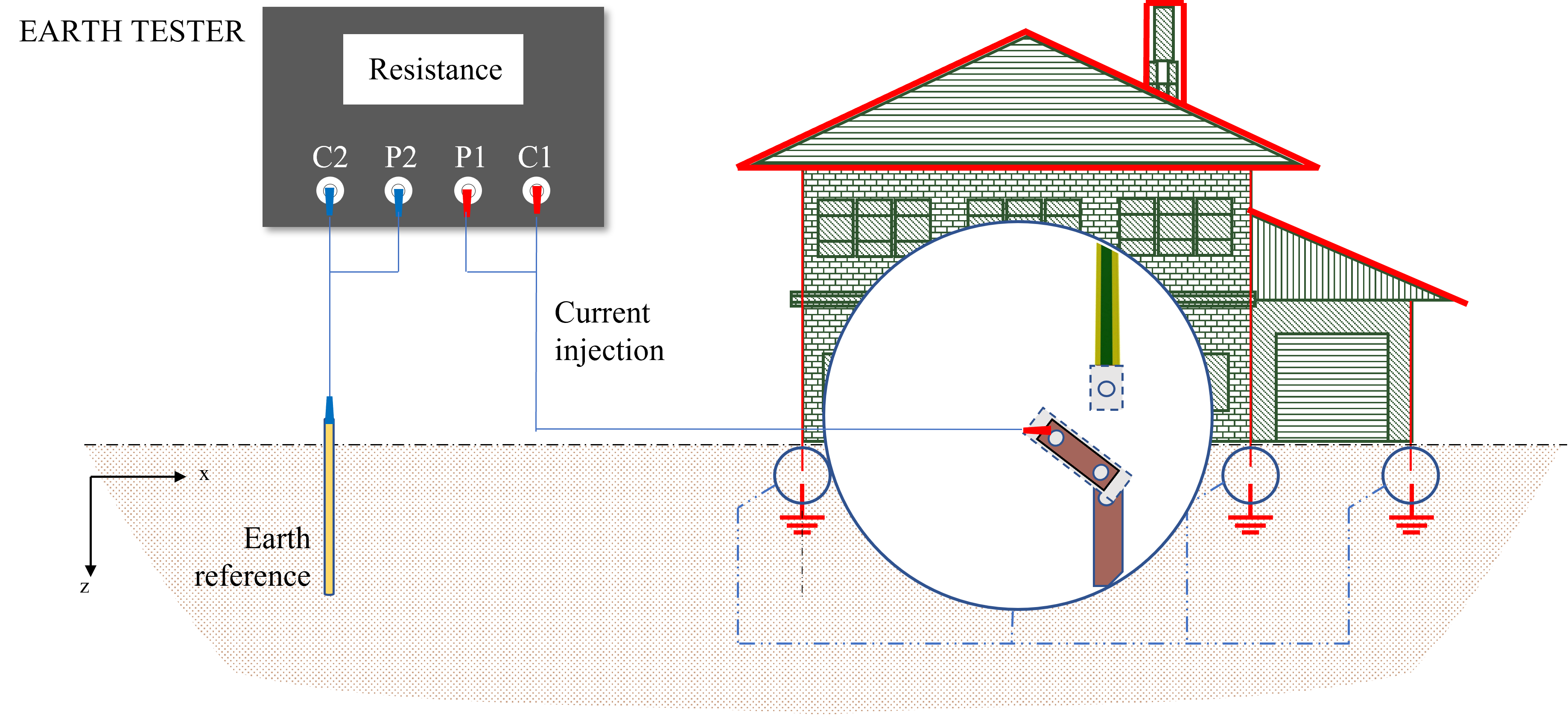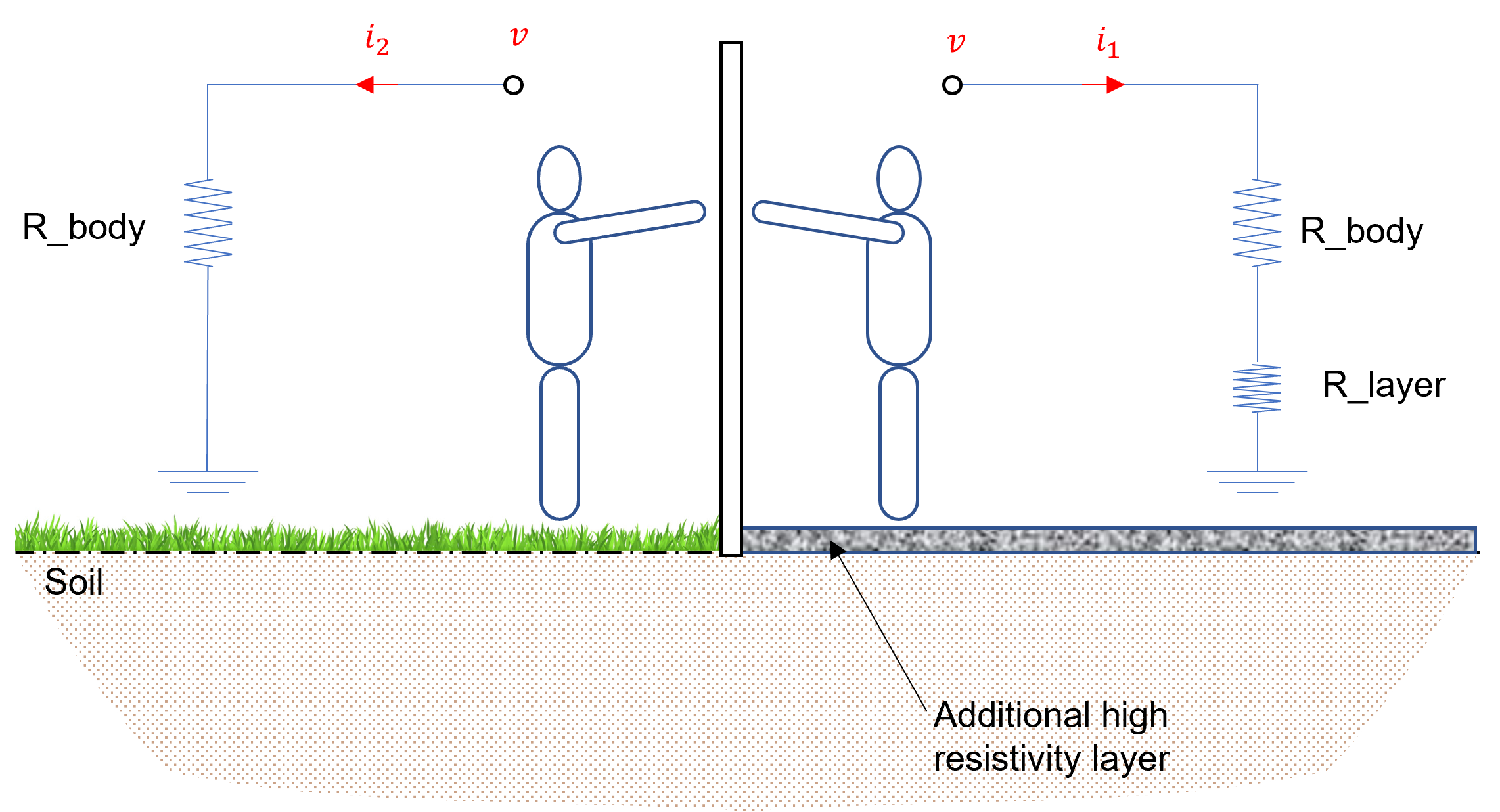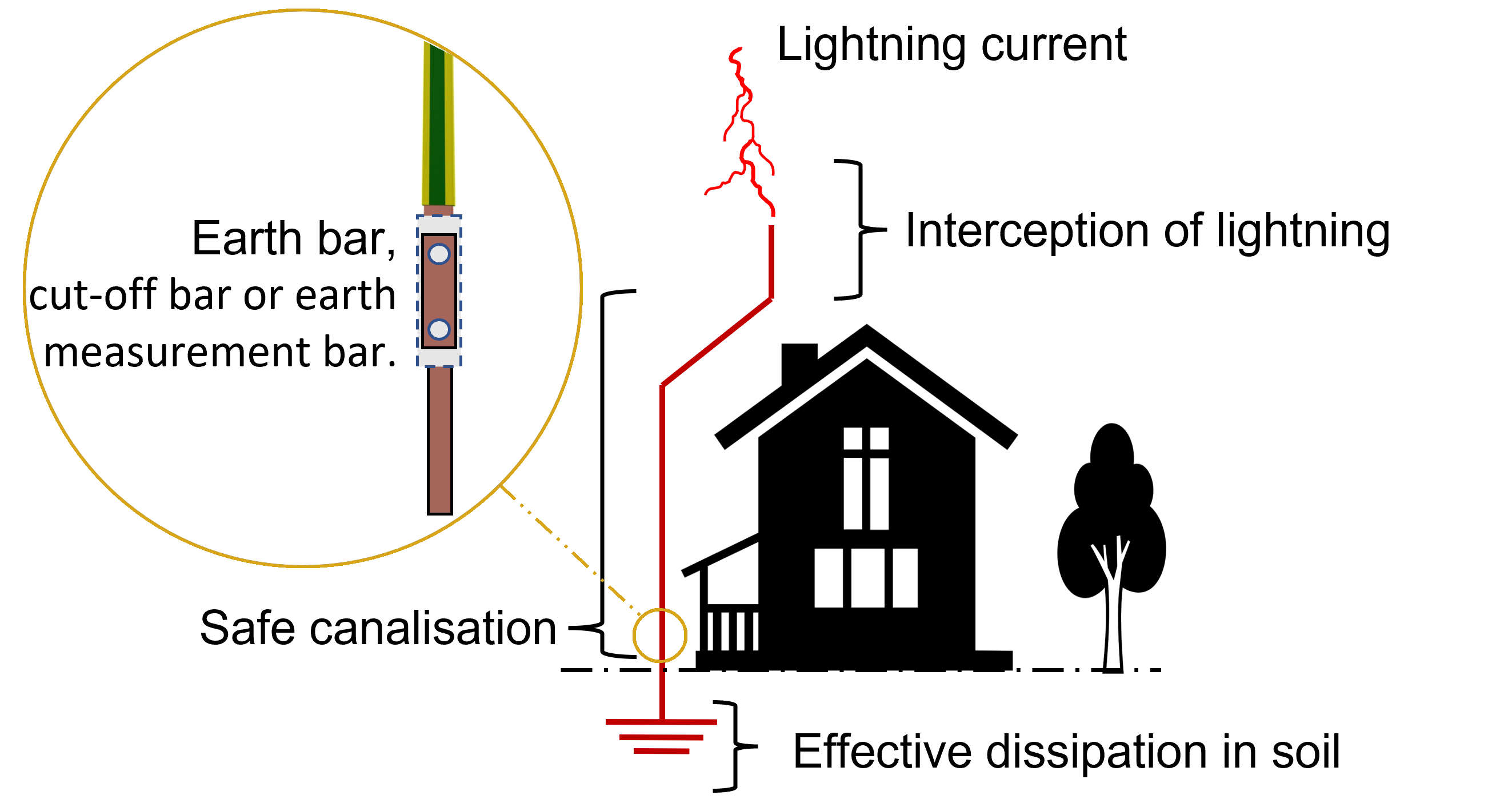Lightning consists of an electric discharge in a long air-gap involving an electrostatic phenomenon of breakdown of the air between cloud and earth. In this case, it is clear that an enormous voltage is involved, which means a huge amount of energy. In fact, lightning prioritizes low resistance/impedance paths; especially good electrical conductors such as metals. Usually, the lightning path is not unique and widely occurs as multiple branches, from which a main branch can be distinguished. This is where most of the energy that can cause damage passes. As explained in Characteristics of Lightning Discharges – Kingsmill Industries , the physical phenomenon of lightning corresponds to an ideal source of impulse current with an actual waveform that is very variable (in shape and parameters). For instance, the current amplitude is in the order of a few kA to 250kA and the channel temperature is more than 15,000◦C. The current wave has a rising edge to the maximum amplitude, from a few microseconds to 20µs, followed by a decay tail of a few tens of microseconds. The spectral range associated with atmospheric lightning discharge extends in a frequency band from a few kHz to several MHz.
Overall, cloud to earth lightning discharges always cause intense currents to flow towards the earth, sometimes through natural (such as trees) or man-made (building structures, trees) or man-made elements. wind turbines, · · · etc.). Lightning surges come, in fact, either from a direct impact or from an electrostatic (or electromagnetic) influence.
Direct strikes are less common than other ways in which lightning strikes people, but they are likely to be the most deadly. More than a third of lightning strike deaths occur in open areas. Other common places are industrial locations and private residences. Construction and material handling such as loading and unloading are two of the most common work-related activities where lightning strikes occur. Generally, direct strikes happen most often to people who are in open areas, so that the person becomes part of the main lightning discharge channel. Heat from the movement of lightning over the skin can cause burns, and part of the current moves through the body – usually through the cardiovascular system and/or device nervous. This current passing through the body poses a great danger, and the likelihood of surviving any lightning strike depends on immediate medical care, as well as on the amount of current that moves through the body. The effects of direct lightning strike occur by conduction of lightning current in more or less conductive elements, causing electric shock to people, equipment failure or structure destruction. Figure 1 represents the most common direct effects of lightning discharge.
Because of its huge energy, this type of discharge easily leads to ignition, primarily when the lightning duration is relatively long. Many other thermal effects can also appear, which are linked to the quantities of charges brought into play during lightning strikes. They result in more or less significant melting points at the impact level when it comes to materials of high resistivity. On poor conductive materials, a great deal of energy is released in the form of heat. The moisture they contain then causes a sudden localized overpressure that can go until they burst.
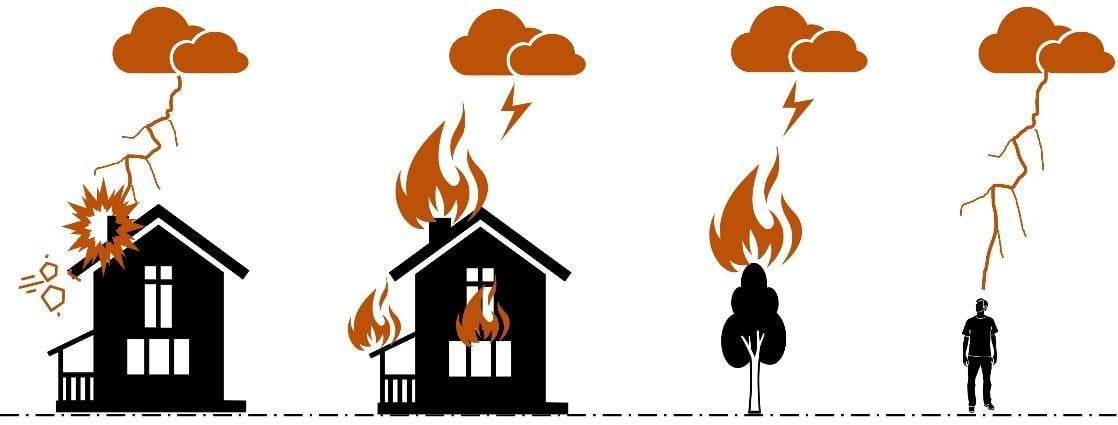
It is well known that an indirect strike represents a situation in which a person or a structure is indirectly exposed to an electric shock resulting from a lightning discharge. For instance, it occurs when a person approaches a physical object that has previously been exposed to an electric shock caused by lightning. Moreover, lightning current can be transmitted over long distances in wires or other metal surfaces. Figure 2 illustrates a representation of ways how lightning currents can indirectly affect a structure.
As shown in this figure, current can be transferred by electromagnetic field radiation, earth potential rise, conduction, and so on. Most lightning injuries and damage of electronics that occur inside structures are caused by conduction, which is resulted from a lightning strike. Metallic materials provide a conductive path for the lightning current. In other words, a person is at risk when touching objects connected to metal wires, plumbing pipes or surfaces during the lightning event.
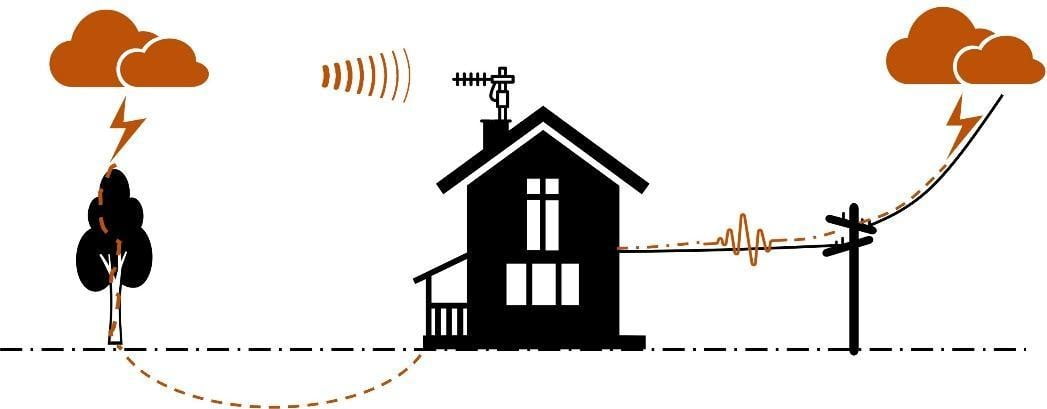
In addition, metal extending outwards could endanger it, and this includes anything plugged into an electrical outlet, water faucets, wired phones, windows and doors.
Protection against lightning and switching transients is a necessity in electrical installations. It should be noted that this protection depends on the nature (atmospheric or industrial) and parameters (amplitude, shape, duration, · · · etc.) of the overvoltage as well as on the size and characteristics of the electrical system to be protected. For this purpose, different topologies and protection procedures are proposed in this field of protection.
In the lightning protection field, the primary function of a protection system is providing a low impedance path for an effective flow of lightning currents to the earth. For safety reasons, lightning protection systems must also react to any induced electrical potential such as that developed on the ground surface around the point of current injection. Therefore, the protection system may differ from one system to another according to multiple factors such as the system to be protected and transient source. In fact, the protection is intended to avoid such currents and induced potentials – by intercepting canalizing and then discharging currents into the ground. Figure 3 shows a representation of the basic configurations used for lightning protection.
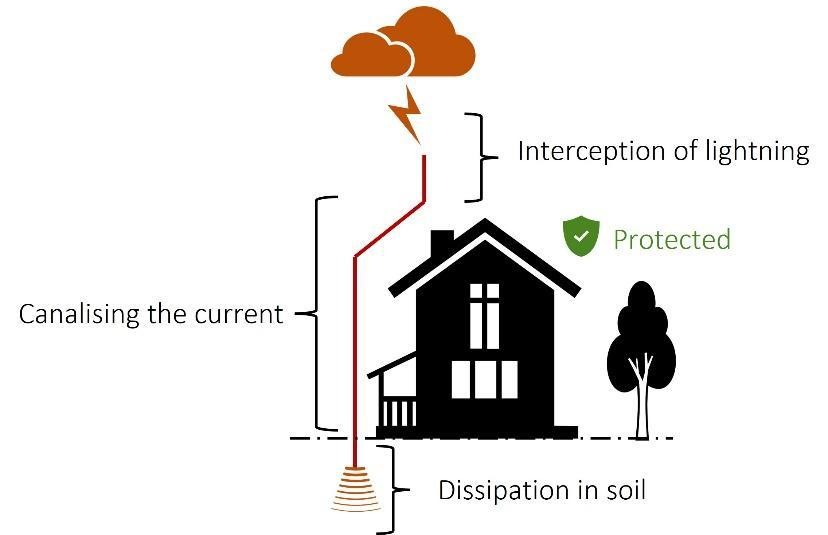
Indeed, systems and structures cannot be isolated from the external world and from the effects of lightning discharges. This means that the structure may also be affected by indirect effects of lightning, which are numerous. For instance, when lightning strikes the conductors of transmission or distribution lines, an overvoltage can propagate along the conductors and is possibly transmitted to devices located in the connected structures. For this reason, the external lightning protection systems should be completed by additional measures to avoid the induced and/or transmitted currents. This system is widely called an internal lightning protection system.
All the electrical, electronic and computer elements should be protected against the indirect effects of lightning. The most important element in the internal protection system is the surge arrester. In general, surge arresters are intended to protect against transient overvoltage induced from lightning or from industrial origin (e.g., switching in power electronics, ferro-resonance, etc.). The function of the surge arresters consists in neutralising the overvoltage by deflecting the corresponding overcurrent safely towards the ground. Figure 4 illustrates a representation of the basics of an internal lightning protection systems.
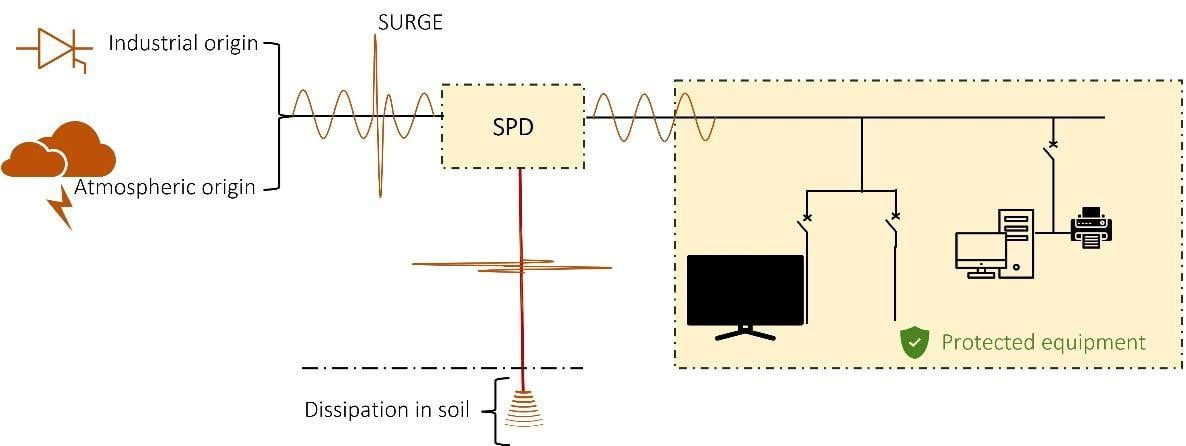
Unlike fuses, surge arresters or SPDs have repetitive operation and no regular replacement is required after each operation. Designing of these devices depends on multiple factors such as the time constant and the magnitude of the overvoltage. In addition, correct cabling of these components is essential to their effectiveness. Overall, prevention of dangerous sparking in the structure is one of the main functions of an internal lightning protection system.
In order to protect a structure against lightning, a protection system must be designed in accordance with lightning protection standards such as BS EN 62305, NF EN 62305, NF C 17-102, UTE C 15-443, and so on. This system is made up of several elements to ensure the protection of the integrity of the structure: it is the external installation of protection against lightning. As shown previously, an external lightning protection system is the outer part of the lightning protection system intended to intercept, conduct and flow lightning current safety to the earth. A typical external protection is made up of (i) an interception system intended to be the preferred point of impact for lightning, (ii) one or more down conductors used to ensure the flow of lightning currents to the earth, and (iii) an earth connection that is ensuring the dissipation of these currents while limiting the risks for systems and people near the installations
Different systems allow the interception of lightning strikes on a structure. The most basic technique consists in an outer mesh cage set up around the structure to be protected. Actual market offers multiple choices and a wide range of materials and components such as solid tape of different shapes and stranded conductors. These bare and/or coated conductors provide designers with the required flexibility to blend an effective lightning protection network, specially into the building facade. Figure 5 shows an example of an outer mesh cage used as an air-termination system.
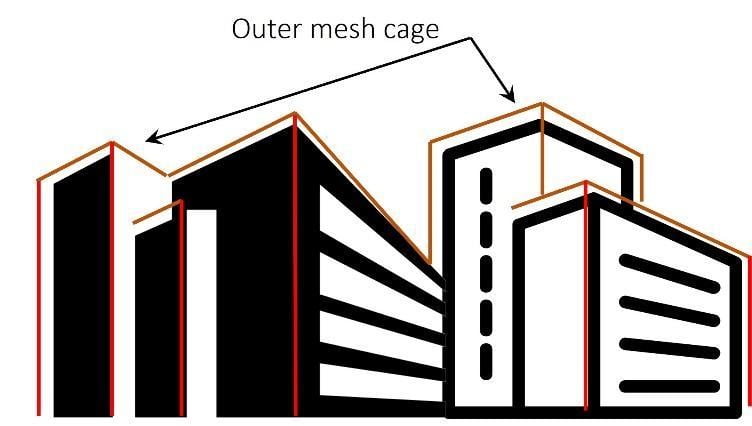
As shown in this figure, a passive protection solution for buildings consists in an outer mesh cage, forming a “Faraday cage” where the system to be protected should be inside this cage. In most cases, this system is enhanced by spikes placed in different positions on the building roof such as around the perimeter of the building. These simple spikes should be linked together by a mesh formed either from a conductor placed on the roof, or from wires stretched across the roof above the structure to be protected. Figure 6 illustrates the most commonly used air terminals in passive protection systems.

It should be noted that a lightning air-termination system can be equipped with an electronic device that generates high voltage pulses to ensure faster tripping of the upward tracer, and intended for large areas (NFC 17-102 standard).
A single lightning air-terminal (passive and/or active devices) can be used without mesh to protect small areas (standard NF EN 62305). These systems are also ideal where space is in limited supply such as roof-mounted plants or solar PV panels, leading to optimise the lightning protection design.
It is worth noting that the sizing of these external lightning protection systems depends on the lightning protection level, which is dependent on parameters such as the sensitivity of an installation (presence of hazardous materials, risk of panic, etc.) and its exposure to the lightning phenomenon. Depending on the results of the lightning risk analysis, a technical study should be carried out by a competent body, precisely defining the prevention measures and protection devices, the location of their installation, as well as the methods of their verification, control and maintenance.
In lightning events, the current captured by the lightning air-termination system is channelled through conductors to the earth. Therefore, down conductors play an important role in the protection against lightning strikes. Conductors must allow lightning currents to flow effectively between the points of impact (mesh or mast) and the earth. These down conductors must be sufficiently sized to reduce any possible risk of ignition with the metallic masses of the installations. In addition, special attention should be paid to the electromagnetic radiation associated with the passage of high magnitude currents.
This is why down conductors are usually installed outside the building, avoiding the proximity of electrical pipes and gas pipes.
It should be noted that the path of down conductors must be as straight as possible, following the shortest path to land and avoiding any formation of bends or sudden ascent.
Figure 7 presents a comparison between two dispositions of down conductor in a typical building.
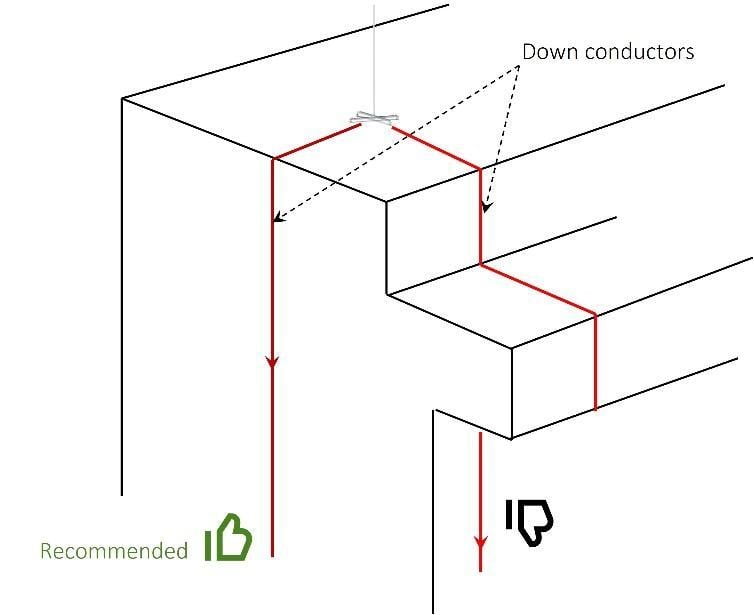
In order to ensure the path of lightning currents from the mast to the earth, an effective earthing system should be installed. In fact, the choice of earthing systems depends on multiple factors (lightning parameters, structure, … etc.). Different methods to realize an earthing system, which can be in the form of a loop, plate, rods, earthing grid or mesh network as shown in figure 8.

The characteristics of the earthing installation are established according to the result of the calculation of a specific earthing system, such as the number of poles required. Overall, the main objective is to establish a low resistance of the given earthing system, which is able to effectively dissipate the current into the earth and can reduce the touch and the step voltages within limited values.
It should be noted that all components of a lightning protection are made from materials that are resistant to corrosion and they must be protected from accelerated deterioration since many system components will be exposed to the atmosphere and climate. For this reason, combinations of materials that form electrolytic couples in the presence of moisture shall not be used, and current carrying system components must be highly conductive. In addition, prevailing site soil conditions will impact in-earth system components. Therefore, the dimensions and materials of the earth connection conductors must meet the requirements of local and international standards such as IEC 62561-2.
The installation of a lightning strike counter above the protection tube is recommended for checking and maintenance of the installation. It is well-known that the earth resistance must be measured to ensure a good level of protection for the individual, structure and installations.
Power surges produced by lightning discharges may affect the electrical network and cause damages in home appliances. Moreover, transient overvoltage, one of the major sources of lightning-related incidents, are introduced into the installation usually by external wire lines such as low voltage, telecommunications, IT or radiocommunications networks. In order to ensure the continuous protection against lightning strikes, additional measures are needed to protect electronic devices and systems against these surges. A surge arrester is a device intended to limit transient overvoltage and to drain lightning currents to earth. The term “surge arrester” defines all the equipment protection devices against transient overvoltage, whether of atmospheric origin or from networks (e.g., switching overvoltage, etc.). The term surge protector or surge protective device is often used in everyday language to refer to a surge arrester.
In order to respond effectively to the constraints imposed by the different networks, several surge arresters technologies are available, which include spark-gap, varistor or diode-based surge arresters and combined surge arresters using several components. In general, the purpose of these components is to quickly limit the voltages appearing at their terminals by the sudden modification of their impedance at a determined voltage threshold. Thus, a surge protective device contains at least one nonlinear component.
It should be noted that the effectiveness of this protection depends on several factors such as the choice of surge arresters suited to the networks to be protected and to the estimated amplitude of the attack. The selection of the optimised locations of the surge arresters as well as the quality of the connection of the surge arresters both affect the efficiency of the protection system.
If you have any questions regarding this piece or require further information, please do not hesitate to contact us through our website to submit a query.
[1] IEC Standard, IEC 62305, Protection against lightning, 2012.
[2] NF C17-102, Protection against lightning – Early streamer emission lightning protection systems, 2011.
[3] Union Technique de l’Electricité et de la Communication, UTE C 15-443, Protection des installations électriques basse tension contre les surtensions, 2004.
[4] IEC Standard, IEC 62561-2, Lightning protection system components (LPSC) – Part 2: Requirements for conductors and earth electrodes, 2018.

